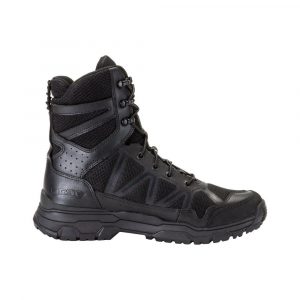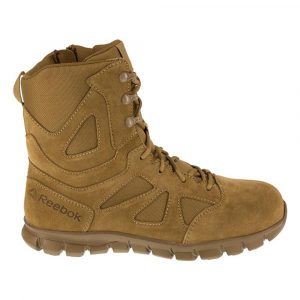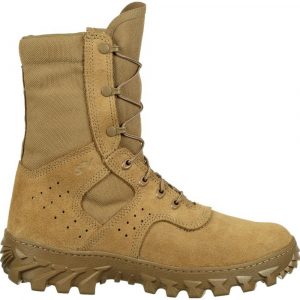
Military boots might all seem the same, but when you have a tough job to do you need to have the right gear. Choosing the right boot means you’re able to do your job effectively without thinking about your feet. Choosing the wrong boot can lead to injuries, unnecessary fatigue in your legs and back, and overall discomfort.
Here’s what you need to consider when you’re choosing a military boot.
Considerations
Before you start browsing new military boots, make sure you know what you need them for. Will you be rucking? Are there specifications that they must follow? Here are some important aspects from different styles of military boots to consider.
Military
Your military combat boots need to meet strict specifications. Air Force personnel need boots that are AFI compliant while Army personnel need boots that are AR 670-1 compliant. You might also need specific colors or features to be compliant for your specific unit or job. For example, many Airmen wear side-zip boots to ensure they can remove them easily in an emergency.
Law Enforcement
 Law enforcement officers have been wearing military-style boots for decades. It makes sense when they are usually on their feet and must do a lot of physical activity. You’ll need a boot that’s flexible enough to keep you agile but comfortable enough to not tire you out when you’re on your feet all day. Law enforcement boots are typically black, but you might have other requirements depending on your department standards.
Law enforcement officers have been wearing military-style boots for decades. It makes sense when they are usually on their feet and must do a lot of physical activity. You’ll need a boot that’s flexible enough to keep you agile but comfortable enough to not tire you out when you’re on your feet all day. Law enforcement boots are typically black, but you might have other requirements depending on your department standards.
Firefighters and EMT
Firefighters and EMT also typically wear black boots, and often need additional safety like a steel toe or a composite toe. You’ll want to make sure your boots have great traction to protect you in all situations. Comfort should play a big role in choosing your boot, so pay special attention to the insole, midsole, and outsole of your boot. Finally, you should make sure your boots meet all OSHA requirements.
Tactical Enthusiast
As a tactical enthusiast, you have a little more freedom when it comes to choosing the right boot. You aren’t constrained by any regulations or colors, just figure out what you’ll be doing when you wear them and find a boot that meets the demands of that activity. Selecting boots that are highly rated by members of the military is a safe bet, but you have the luxury of also being able to wear unauthorized boots – so be on the lookout for cutting edge products that haven’t gotten the military stamp of approval yet.
Get Familiar with the Parts of a Boot
Once you’re ready to start looking at boots, you’re going to see a lot of references to specific parts of the boot. Below is a quick and helpful breakdown of the different terms.
Upper
The upper is the part of the boot that is above the sole and covers most of your foot. The upper of a military boot is often made of leather and nylon to provide durability.
Insole
The insole is what your foot rests on while you’re wearing it. These are typically removable and can be replaced with an aftermarket insole if you feel like you need additional support or cushioning.
Midsole
 The midsole helps provide structure to the sole of your boot and is located between the insole and the outsole. If you’re looking at your boot’s sole, the midsole can often be seen as a slightly different colored line between the bottom of the boot and the upper. The midsole is often where you’ll find the cushioning – like the Reebok Sublite foam midsole in the Reebok Sublite Side Zip Composite Toe Boots.
The midsole helps provide structure to the sole of your boot and is located between the insole and the outsole. If you’re looking at your boot’s sole, the midsole can often be seen as a slightly different colored line between the bottom of the boot and the upper. The midsole is often where you’ll find the cushioning – like the Reebok Sublite foam midsole in the Reebok Sublite Side Zip Composite Toe Boots.
Outsole
The outsole of a boot is located on the bottom. This is an extremely important piece of a military boot because it provides different levels of traction and flexibility. If you’re working on a boat or rucking through muddy conditions, you’re going to need an outsole with great traction. If you’re looking for military boots to run in, then you’ll want to choose an outsole that is flexible.
Boot Height
The boot height refers to how high the boot comes up from the heel of your foot and up toward your knee. The height can offer additional ankle stability and help prevent injuries, with most military boots measuring 8”.
Toe
The toe is the part of the boot that protects your toes. You’ll typically choose between composite toe military boots, soft toe boots, or steel toe boots. Both composite toe and steel toes are considered safety toe military boots, but you might need a specific toe construction depending on your job.
Heel
The boot heel is the back part of the boot that supports your heel. Your options are heeled combat boot and an un-heeled one. Also, varying heel heights work better for different foot shapes and missions.
Find a Boot that Stands Up to the Elements
We know you want a boot that will stand up to some pretty tough conditions. The question is, what will those conditions be? You need to make sure that your boots are designed for the climate and work you’ll be doing, or else there is risk of injury (and discomfort).
Weather
 Jungle boots are designed to stand up to hot, wet, humid weather that is typically found in jungles. These are not all leather since that would be uncomfortable in these conditions. Instead, they rely on nylon to repel water and help your feet breathe. This style of boot also tends to have a pretty intense tread on the sole to provide extra traction in muddy jungle weather. Take a look at the increased lug depth on the sole of the Rocky S2V Enhanced 8 Inch Jungle Boot for a great example of a boot with some grip.
Jungle boots are designed to stand up to hot, wet, humid weather that is typically found in jungles. These are not all leather since that would be uncomfortable in these conditions. Instead, they rely on nylon to repel water and help your feet breathe. This style of boot also tends to have a pretty intense tread on the sole to provide extra traction in muddy jungle weather. Take a look at the increased lug depth on the sole of the Rocky S2V Enhanced 8 Inch Jungle Boot for a great example of a boot with some grip.
Hot weather boots and lightweight boots are similar to jungle boots in that they rely on nylon in the uppers to help your feet breathe. The nylon/leather mix on the uppers in the Oakley SI Light Assault Boot 2 shows the benefit of the already lightweight military boots that now also have moisture wicking properties to help keep your feet dry.
Cold Weather boots work opposite to the hot weather boots. These have special technology in the upper that helps insulate your feet and keep them warm and dry. They tend to be highly slip-resistant and often use additional technology to protect your rubber outsoles from getting hard when they go from extreme cold to room temperatures.
Order in Time
Military boots take some time to break in. Make sure to secure your pair with plenty of time to work them out before training or a mission. Our guide to breaking in your boots can help make sure they’re ready to go whenever you are.
Get the Right Size
Once you know what you want and need in a boot, it’s time to focus on getting the right size. This step is extremely important since a shoe that’s too small will be uncomfortable, and a shoe that’s too big can be dangerous.
Use a Brannock Device
Don’t trust the shoes you already have in your closet to figure out your size. You really need to be measured using a Brannock device which is the special tool that shoe salespeople use to help you find your fit. You should make sure you’re getting measured both sitting down and standing up since your foot’s arch may flex and grow once you put weight on it. These tools also measure the width of your foot, so pay attention if your foot is particularly wide or narrow. You can go to a shoe store to get professionally measured or order one online and do it yourself at home.
Try Them On
Once you have the right boot in the right size, it’s time to test them out. Be sure you’re wearing the type of socks you typically use training or on mission, and include any special inserts you plan on using when you’re testing your shoes. It may not seem like a big deal, but those two factors can really change the way the shoe fits and feels.
Adjust the laces
Your laces aren’t just for keeping your foot in. They can play a big role in adjusting the fit and feel of your boot. Try adjusting them throughout the entire boot in order to customize it to your foot.
Walk, run, and jump
You’re not going to be just standing still in your boots, right? So, make sure you try being active when testing them. Walk, run, jump, lunge – do whatever you need to see how those babies feel on your feet. Pay attention to anywhere the boot might rub or pinch, because that is only going to get worse over time. We recommend wearing them for at least 15 minutes before making a decision about how they feel. If you’re trying these boots on at home and not in a store, make sure you test them inside and on carpet or another soft surface to protect the sole. Depending on where you bought them, the manufacturer may not take them back if they are scuffed or damaged.
Find the Right Insoles and Socks
Finding the right boots is a big step in the right direction. Once you’ve got them, you should make sure you have the right socks and consider an after-market insole.
Socks
 Socks are a key part of your footwear and you should never wear your boots without them. The right socks can keep your feet dry, at the right temperature, and can prevent blisters and bacteria growth. Find the right pair for your situation using our guide to military socks.
Socks are a key part of your footwear and you should never wear your boots without them. The right socks can keep your feet dry, at the right temperature, and can prevent blisters and bacteria growth. Find the right pair for your situation using our guide to military socks.
Insoles
Insoles can change the fit and feel of your boot for the better. You can choose between comfort, support, and custom orthotic insoles – check out our insole guide to find the right fit.
Your military boots are not a place where you can skip the research or just shop the bargain bin. You really need to choose the boot that’s right for your job, your foot, and the conditions ahead. This guide can help you order online, or stop by a US Patriot store and one of our friendly team members can help you find the best boot for your mission.






